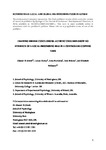Drawing Firmer Conclusions: Autistic Children Show No Evidence of a Local Processing Bias in a Controlled Copying Task
| dc.contributor.author | Smith, Alastair | |
| dc.contributor.author | Kenny, L | |
| dc.contributor.author | Rudnicka, A | |
| dc.contributor.author | Briscoe, J | |
| dc.contributor.author | Pellicano, E | |
| dc.date.accessioned | 2017-12-06T10:38:42Z | |
| dc.date.available | 2017-12-06T10:38:42Z | |
| dc.date.issued | 2016-08-17 | |
| dc.identifier.issn | 0162-3257 | |
| dc.identifier.issn | 1573-3432 | |
| dc.identifier.uri | http://hdl.handle.net/10026.1/10372 | |
| dc.description.abstract |
Drawing tasks are frequently used to test competing theories of visuospatial skills in autism. Yet, methodological differences between studies have led to inconsistent findings. To distinguish between accounts based on local bias or global deficit, we present a simple task that has previously revealed dissociable local/global impairments in neuropsychological patients. Autistic and typical children copied corner elements, arranged in a square configuration. Grouping cues were manipulated to test whether global properties affected the accuracy of reproduction. All children were similarly affected by these manipulations. There was no group difference in the reproduction of local elements, although global accuracy was negatively related to better local processing for autistic children. These data speak against influential theories of visuospatial differences in autism. | |
| dc.format.extent | 3481-3492 | |
| dc.format.medium | ||
| dc.language | en | |
| dc.language.iso | en | |
| dc.publisher | Springer Science and Business Media LLC | |
| dc.subject | Autism | |
| dc.subject | Drawing | |
| dc.subject | Global | |
| dc.subject | Local | |
| dc.subject | Coherence | |
| dc.subject | Grouping | |
| dc.title | Drawing Firmer Conclusions: Autistic Children Show No Evidence of a Local Processing Bias in a Controlled Copying Task | |
| dc.type | journal-article | |
| dc.type | Journal Article | |
| plymouth.author-url | https://www.webofscience.com/api/gateway?GWVersion=2&SrcApp=PARTNER_APP&SrcAuth=LinksAMR&KeyUT=WOS:000386782700009&DestLinkType=FullRecord&DestApp=ALL_WOS&UsrCustomerID=11bb513d99f797142bcfeffcc58ea008 | |
| plymouth.issue | 11 | |
| plymouth.volume | 46 | |
| plymouth.publication-status | Published | |
| plymouth.journal | Journal of Autism and Developmental Disorders | |
| dc.identifier.doi | 10.1007/s10803-016-2889-z | |
| plymouth.organisational-group | /Plymouth | |
| plymouth.organisational-group | /Plymouth/Faculty of Health | |
| plymouth.organisational-group | /Plymouth/Faculty of Health/School of Psychology | |
| plymouth.organisational-group | /Plymouth/REF 2021 Researchers by UoA | |
| plymouth.organisational-group | /Plymouth/REF 2021 Researchers by UoA/UoA04 Psychology, Psychiatry and Neuroscience | |
| plymouth.organisational-group | /Plymouth/Users by role | |
| plymouth.organisational-group | /Plymouth/Users by role/Academics | |
| plymouth.organisational-group | /Plymouth/Users by role/Researchers in ResearchFish submission | |
| dc.publisher.place | United States | |
| dcterms.dateAccepted | 2016-08-05 | |
| dc.identifier.eissn | 1573-3432 | |
| dc.rights.embargoperiod | Not known | |
| rioxxterms.versionofrecord | 10.1007/s10803-016-2889-z | |
| rioxxterms.licenseref.uri | http://www.rioxx.net/licenses/all-rights-reserved | |
| rioxxterms.licenseref.startdate | 2016-08-17 | |
| rioxxterms.type | Journal Article/Review |


